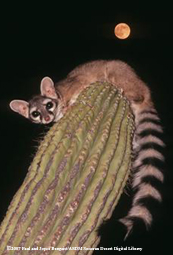Animal Fact Sheet: Ringtail |
Identifying Features The ringtail (Bassariscus astutus) has many identifying features. The problem may be seeing one in order to identify it! They have a long tail with alternating bands of white and black fur. They have large eyes surrounded by white rings of fur, large rounded ears, short legs and a long grayish colored body.
|
 |
Adaptations Ringtail are excellent climbers capable of ascending vertical walls, trees, rocky cliffs and even cacti. They can rotate their hind feet 180 degrees, giving them a good grip for descending those same structures. They have excellent eyesight as well as hearing, both helpful adaptations for a nocturnal animal. |
Habitat The ringtail prefers to live in rocky habitats associated with water. These areas can include riparian canyons, caves, and mine shafts. |
Range Ringtails can be found from southwestern Oregon, south through California, southern Nevada, Utah, Colorado, Texas, Arizona, New Mexico, Oklahoma, Kansas, Baja California and northern Mexico. |
Wild Status The ringtail is classified as Least Concern (LC) on the IUCN Red List. |
Diet Ringtails are omnivores which means they will eat just about anything if it is the right size. Some of their food choices are fruit, insects, lizards, snakes, small mammals such as mice, woodrat's, squirrels, as well as birds and bird eggs |
Predators Ringtail predators include great horned owls, bobcats and coyotes. |
Home A ringtail home is called a den. They will den in tree hollows, rock crevices, other animals' abandoned burrows, mine shafts, abandoned buildings and some are even known to find their way into attics of occupied homes. |
Life Span In the wild a ringtail will live around 6-9 years. They live much longer in a zoological setting. |
Size They weigh about 1-2 pounds and are 24 inches in length (including the tail). |
Extra Fun-facts
|
 ©Copyright 2008, Arizona-Sonora Desert Museum
©Copyright 2008, Arizona-Sonora Desert Museum